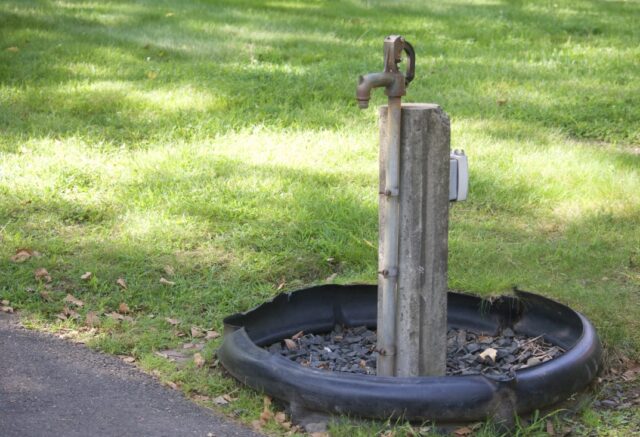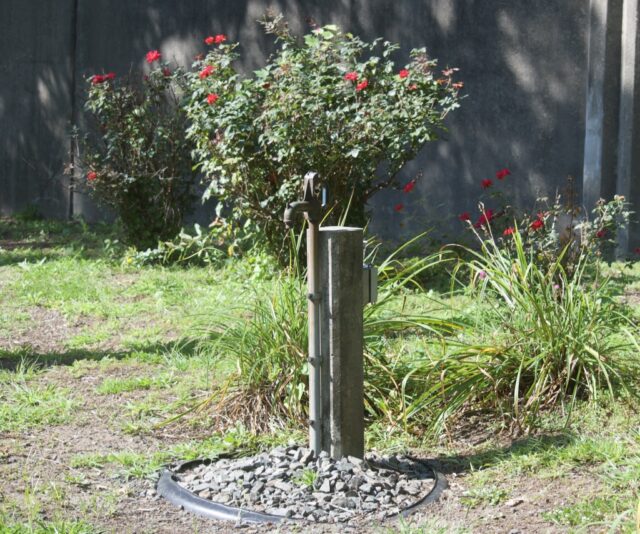Last month when I wrote about a leaking faucet in a cemetery, there were a few things I did not get a chance to mention.
One: It does not have to be that way. There are several faucets (hydrants) along the Connecticut River path and these are not dripping endlessly. Same with what is viewed in other cemeteries.
Two: There are ways to install the hydrants/faucets to be less troublesome in first place. See the photos in this post. Water is more contained. Between the crushed stone and the plastic barrier, water is discouraged from running off onto the pavement and gathering any contaminants there. The paved multi-use path is not a highway, but vehicles do use it, and as we know, vehicles drip fluids. A lot of this design is really to prevent freezing in winter. The ring also keeps lawn mowers from hitting faucets. That seems like something that would be handy in the cemetery; I’ve been told a fair amount of what people assume is vandalism to gravestones is actually the result of landscapers hitting stones (and other things) with lawn mowers. This is not a suggestion to surround tombstones with plastic barriers.

Three: A few months ago I read Dude Making A Difference after a friend suggested it, and one of the details that stuck with me was how he cycled from New York City to Boston during a heatwave, and drank only what would have been wasted water. Spoiler: he survived. This meant drinking water from leaky faucets and fire hydrants.
This was an intense part of a much longer attempt at water conservation by the author in which he relied largely on water from off-the-grid.
What I love about these kinds of challenges — No Impact Man is another one — is that they prove how much less we could use. Of course, there are those who encounter such narratives and have a wild, knee-jerk reaction of “I could never do that,” missing the whole point: nobody is asking you to. It feels personal because of how many people volunteer that they “could never give up their car,” when I have not asked them to, yet somehow “use public transportation or a bike one day a week” gets translated into that. Nobody is asking them to sip from hydrants or go years without showering. There is a huge gap between how many of us live and how much simpler we could be living, and most of us could take several steps toward a less cluttered life without being any less comfortable.
It’s a rhetorical device, actually, that is used in commercials all the time. We’re shown deodorant, watches, sneakers being used in scenarios that most of us would never subject them to. We’re all familiar with the quite sexist slogan “Strong Enough for a Man, Made for a Woman.” If that watch can withstand a James Bond-style car chase with missiles and a helicopter, then surely it will endure my tame daily life in which I might bump it against a door.

A few years back I stayed in a cabin that had no running water. There was a jug of potable water, and unless I put in a special request for a refill, this is what was to last me for the next few days. This is how I got my drinking water, how I washed my hands, how I cleaned dishes. There were no plans in my mind about continuing to do this beyond my stay, but it highlighted how even when I thought I was conscious about water use, I could be better about it.
I did not come back to Connecticut ready to give up showering, but I did make more thoughtful use of water and swapped out the shower head (which was due for replacement anyway) for a low-flow model. I don’t think I ever let water run while brushing my teeth, but I have become the person who will shut off the flow when someone else is doing that. Not on my watch! That’s about half the water I would have used in one day!
My takeaway from reading about someone’s bike ride with fire hydrant water is not that we should all be out there drinking water dripping from faucets, but that beyond repairing these leaks, we could do a better job of capturing water that would have been wasted and using it in other ways.
Climate Possibilities is a new series about climate mitigation, along with resilience, resistance, and restoration. It’s about human habitat preservation. It’s about loving nature and planet Earth, and demanding the kind of change that gives future generations the opportunity for vibrant lives. Doomers will be eaten alive, figuratively. All photographs are taken in Hartford, Connecticut unless stated otherwise.
Strong Enough
Last month when I wrote about a leaking faucet in a cemetery, there were a few things I did not get a chance to mention.
One: It does not have to be that way. There are several faucets (hydrants) along the Connecticut River path and these are not dripping endlessly. Same with what is viewed in other cemeteries.
Two: There are ways to install the hydrants/faucets to be less troublesome in first place. See the photos in this post. Water is more contained. Between the crushed stone and the plastic barrier, water is discouraged from running off onto the pavement and gathering any contaminants there. The paved multi-use path is not a highway, but vehicles do use it, and as we know, vehicles drip fluids. A lot of this design is really to prevent freezing in winter. The ring also keeps lawn mowers from hitting faucets. That seems like something that would be handy in the cemetery; I’ve been told a fair amount of what people assume is vandalism to gravestones is actually the result of landscapers hitting stones (and other things) with lawn mowers. This is not a suggestion to surround tombstones with plastic barriers.
Three: A few months ago I read Dude Making A Difference after a friend suggested it, and one of the details that stuck with me was how he cycled from New York City to Boston during a heatwave, and drank only what would have been wasted water. Spoiler: he survived. This meant drinking water from leaky faucets and fire hydrants.
This was an intense part of a much longer attempt at water conservation by the author in which he relied largely on water from off-the-grid.
What I love about these kinds of challenges — No Impact Man is another one — is that they prove how much less we could use. Of course, there are those who encounter such narratives and have a wild, knee-jerk reaction of “I could never do that,” missing the whole point: nobody is asking you to. It feels personal because of how many people volunteer that they “could never give up their car,” when I have not asked them to, yet somehow “use public transportation or a bike one day a week” gets translated into that. Nobody is asking them to sip from hydrants or go years without showering. There is a huge gap between how many of us live and how much simpler we could be living, and most of us could take several steps toward a less cluttered life without being any less comfortable.
It’s a rhetorical device, actually, that is used in commercials all the time. We’re shown deodorant, watches, sneakers being used in scenarios that most of us would never subject them to. We’re all familiar with the quite sexist slogan “Strong Enough for a Man, Made for a Woman.” If that watch can withstand a James Bond-style car chase with missiles and a helicopter, then surely it will endure my tame daily life in which I might bump it against a door.
A few years back I stayed in a cabin that had no running water. There was a jug of potable water, and unless I put in a special request for a refill, this is what was to last me for the next few days. This is how I got my drinking water, how I washed my hands, how I cleaned dishes. There were no plans in my mind about continuing to do this beyond my stay, but it highlighted how even when I thought I was conscious about water use, I could be better about it.
I did not come back to Connecticut ready to give up showering, but I did make more thoughtful use of water and swapped out the shower head (which was due for replacement anyway) for a low-flow model. I don’t think I ever let water run while brushing my teeth, but I have become the person who will shut off the flow when someone else is doing that. Not on my watch! That’s about half the water I would have used in one day!
My takeaway from reading about someone’s bike ride with fire hydrant water is not that we should all be out there drinking water dripping from faucets, but that beyond repairing these leaks, we could do a better job of capturing water that would have been wasted and using it in other ways.
Climate Possibilities is a new series about climate mitigation, along with resilience, resistance, and restoration. It’s about human habitat preservation. It’s about loving nature and planet Earth, and demanding the kind of change that gives future generations the opportunity for vibrant lives. Doomers will be eaten alive, figuratively. All photographs are taken in Hartford, Connecticut unless stated otherwise.
Related Posts
Alone In The Woods
Look: Gardens
21st Hartford Marathon and Half Marathon